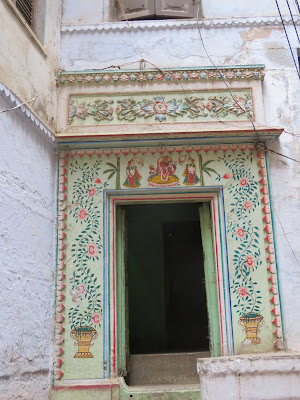Thursday 14 April 2015
Varanasi
I shall begin with photos from last evening's visit to the incredible spectacle at the Ganges River. Photos are not allowed of the actual creamtion process, but visitors are permitted to witness them.









Varanasi
I shall begin with photos from last evening's visit to the incredible spectacle at the Ganges River. Photos are not allowed of the actual creamtion process, but visitors are permitted to witness them.
 |
| First View of the Ganges at Low Tide |
 |
| Crowds Gather to Load Boats |
 |
| Preparing to Enter My Boat (guide standing on right) |
 |
| The Rower of My Boat Pushes Off |

It is impossible for my words to
describe or even record the variety of things I have been witness to here in
Varansi. After the other-worldy experience yesterday of
sunset on the Ganges , today, with the help of another excellent
guide, I plunge into the world of back alleys and narrow streets where the
residents of the old city live, work, and shop.
For about three hours I am immersed in the wild colors (from every range of the palate), vivid aromas
(actually, the smells of cooking food are quite appealing), jostling of
passersby and crowding motorbikes (but no feelings of danger from thieves or
pickpockets; the local people are remarkable honest), and the competing sounds
of human shouting, cattle mooing, electronic music playing, and the clanging of
bells everywhere. In fact, the sound
level is the most difficult aspect of the scene for me. Fortunately there escapes in the quiet
courtyards of Hindu temples, hidden almost everywhere behind the hubbub.
In the morning I take a short walk in the area of the hotel to get a sense of a the more "normal" life of the city, away from the holy sites. I pass a delightful park, names for Nehru, and the shell of the old luxury Hotel de Paris, embroiled in family disputes I am later told by my guide.


My guide in the afternoon is a 27-year-old Veranasi native, who (I am guessing) fantasizes about the life of an Italian (notice his clothes and the Mediterranean way he wears his scarf).
He takes his vacations in Italy and has even earned an Italian driver's license. But having grown up in the neighborhoods of Veranasi, he is an expert on local lore and history. As he takes me through the interconnected alleys and byways of this part of the old city--far removed even from the major nearby streets--he brings to life the variety of scenes I witness as we pass. Without him, of course, I would be lost after the first five minutes, much less after two and a half hours.
I don't take a great many pictures because I spend more time looking down at the dangerous pavement that looking up at the buildings and people (and animals, of course). The most beautiful and peaceful things to see are the several temples we visit, where photography is not allowed. But I do get a few shots of the streets and crowds and the outside of a very special temple built of sandstone imported three centuries ago from Iran (no one knows exactly how).



























__03.jpg)